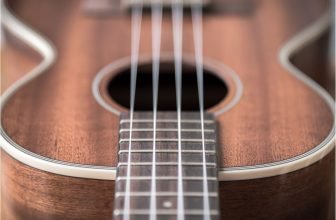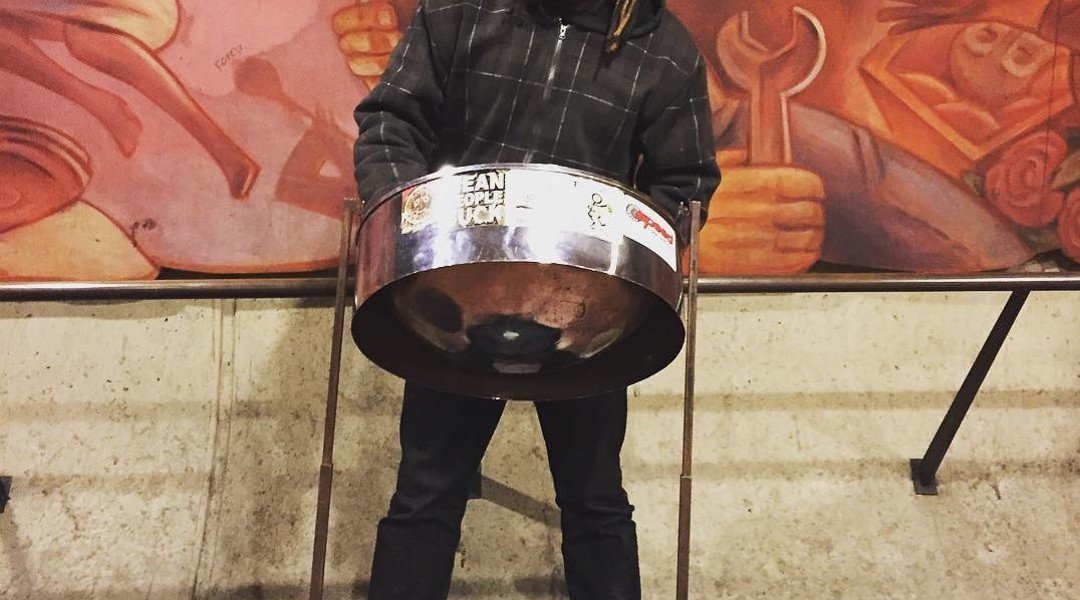Best Soundproof Curtains — Don’t Mess with My Herz
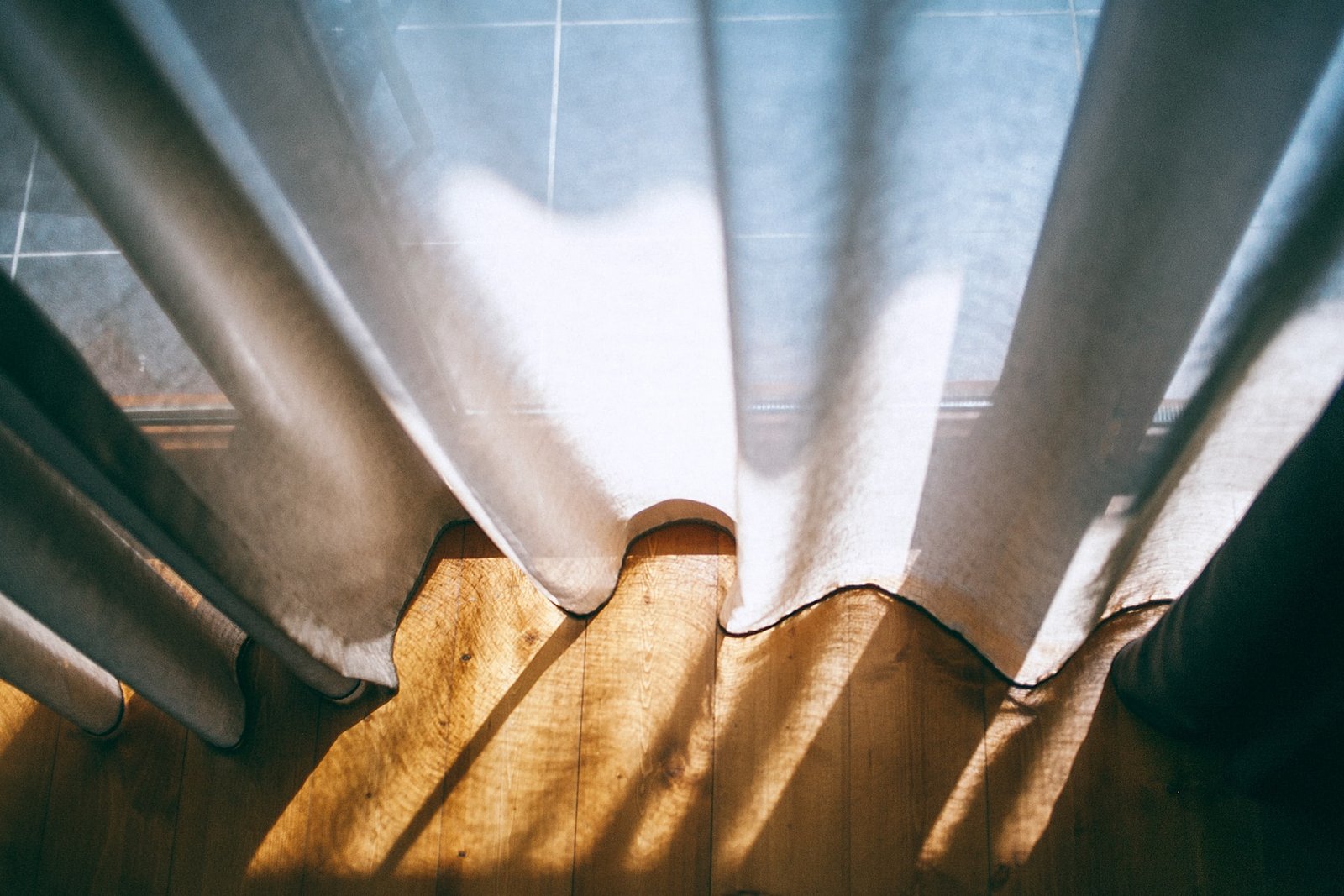
For a musician, it’s imperative to work in a room with acoustic treatment. And you know why:
- External noise. If you’re a recording artist, you don’t want to besmirch your takes with random sounds: traffic noise, dog barking, or neighbors arguing. If you want natural ambiance effects, quality acoustic treatment will help achieve it.
- Internal noise. Noise complaints are what all of us have dealt with. Your parents, spouse, neighbors — you got reprimanded by at least one of them.
- Engineering. If you dabble in mixing/mastering, you know how important it is to exclude unwanted sound artifacts that can blend with the feedback from your monitors.
The list can continue, but you’ve got the idea. So, I’ve prepared my soundproof curtains reviews featuring the top 7 picks.
Table could not be displayed.The best on the list is Nicetown Blackout curtains. They combine low price, more than satisfying quality, and great sound-dampening. Moreover, they provide amazing blackouts.
Other models are worthy options too. So, judging by the pros and cons I provide, you can make a clever choice and take your home studio to the next level.
Top 7 Sound-Killing Curtains
Contents
- No products found.
- No products found.
- No products found.
- No products found.
- No products found.
- No products found.
- No products found.
These models offer different prices, although most of them are budget-wise. I have tried to review everything: from sound-reduction to their aesthetic value.
1. NICETOWN Blackout Curtains — Best Curtains for Noise Reduction
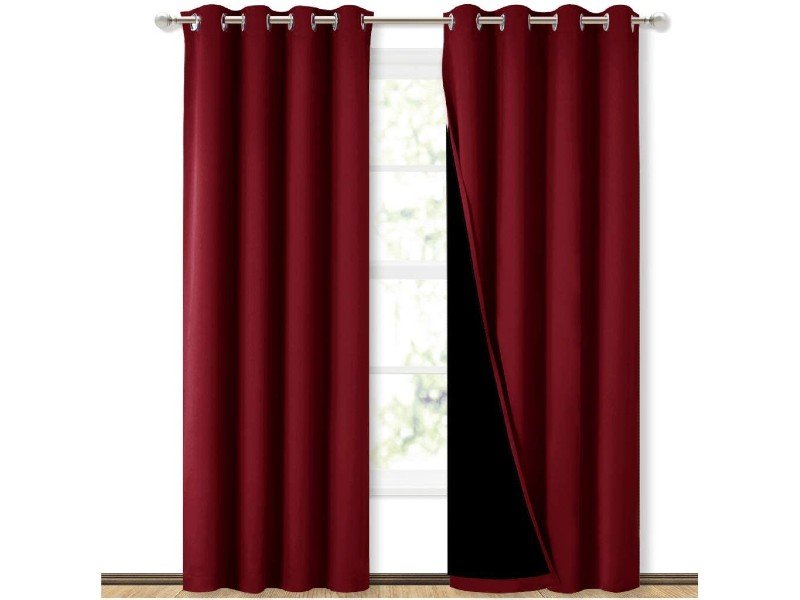
Our first item is from the Nicetown company — a brand that’s been producing tablecloths, blinds, and custom curtains since 1999. And soundproof drapes are one of their specializations.
For starters, I really like Nicetown’s design. The curtains present two layers of triple-weave fabric that blocks sunlight and noise from the outside. Add to it the black-liner backing, and these curtains turn into some sort of black hole that literally devours photons and decibels.
Thanks to the thickness, Nicetown does a stellar job at intercepting broad-spectrum acoustic frequencies. Highs like yelling kids or mids like a buzzing scooter passing by will be canceled right away.
And ‘fat’ lows from someone’s grotesquely boosted car stereo or a landing plane will be nicely attenuated. Noises will have to stay outside your house/studio for good, it seems.
That’s why I can highly recommend having them in a bedroom recording studio. Especially, if you live in an urban area or near a busy road with incessant traffic. Nicetown soundproof curtains will do a killer job at muffling the pesky noises, stopping them from reaching your mic and ruining a take.
But while keeping the street noises out, Nicetown won’t let the sounds of your rehearsal drumming/singing/soloing out either. Flams, rolls, and paradiddles will bounce off of these curtains retaining your… musical privacy, so to say.
A pleasant side effect is a thermal reduction. On a sunny day, these curtains can turn your room into almost a pitch-dark cavern of solitude. That’s how good they are at filtering light.
And if you live somewhere in Fort Myers or Sacramento, these drapes will do a mighty job at stopping the heat. Even if asphalt outside is melting like gelato. Needless to say, after a month of using this, your electricity bill will be a tad thinner.
To sum up, Nicetown is the best noise-reducing curtains I could find. It’s pretty affordable, cleverly designed, and by far the closest to the “blackouts” model that I know. So, don’t sleep on these!
No products found.
- Impressive thickness;
- Grommet type;
- Filters out sound & UV rays;
- Helps lower temperature;
- Great for noisy areas.
- May require some ironing.
.
2. H.VERSAILTEX Blackout Patio Curtains — Reliable Noise & Light-Killers

Our runner-up is a set of nice polyester curtains from H.Versailtex. These seem ideal for large windows as their parameters are 100-inch width x 108-inch width. And, according to the brand, they qualify to be “blackout” ones.
So, their anatomy includes microfiber polyester with a triple-weave backing. Polyester itself, just like other fabrics, is fairly porous. It allows some noises to “leak” through. But this multilayered design tangibly decreases the leakage and muffles noises efficiently.
But I wouldn’t describe them as 100% blackout curtains. In reality, they provide only about 85-90% percent of outside light and sound screening. So, be ready for occasional “leakages” of both visual and acoustic nature.
At least, H.Versailtex has no polyvinyl chloride (PVC) in its formula. It means that you won’t have to harbor a nasty, toxic component inside your house. It’s good for both your health and the local ecosystem of where you live.
At the same time, the curtains are easy to handle. These noise blocking-curtains have standard grommets for attachment, and you can bring the budget sound isolation basically anywhere: to your bedroom, kitchen, attic, garage… Any place with windows.
I also like how elegant they look and how soft they feel. Of course, it won’t make them better at sound stifling , but hey: an artist deserves a nice-looking place to create magic. Inspiration and aesthetics are Siamese twins, after all.
What I also like about them is the 8-year warranty. By far, this is the longest one I’ve seen around. And if they put that much trust in their product, then I guess it must be a worthy option to consider.
No products found.
- No PVC;
- Large size;
- Multi-layered design;
- Affordable.
- Not entirely ‘blackout’.
3. NICETOWN Blackout Curtains for Bedroom — Budget Noise-Cancelling Curtains
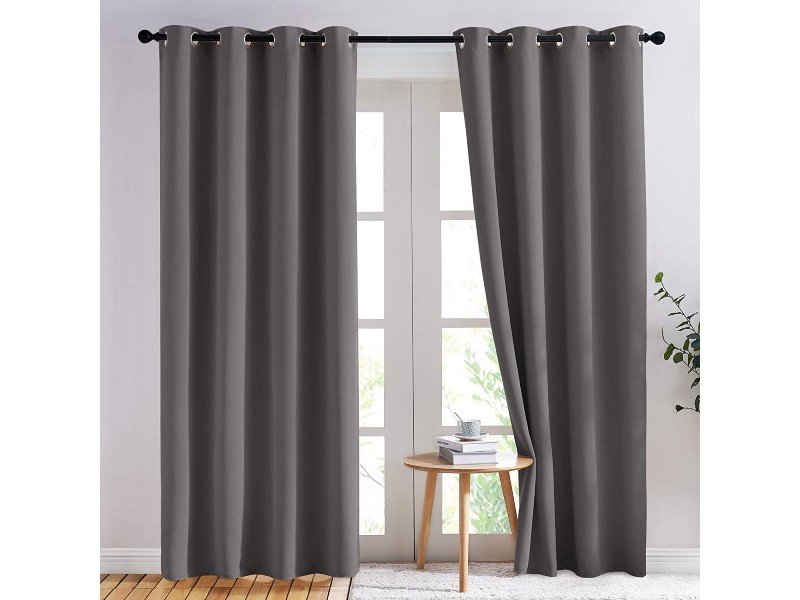
Our third best product is again by Nicetown. It is a set of two panels with 84 x 52 x 0.2-inch dimensions, but there are multiple size choices, as well as different coloring options from biscotti beige to coral salmon and cappuccino.
They are made from microfiber polyester and feature an additional backing to filter out the blazing sun, cold draft, and numerous outside noises.
However, it’s not a 100% guarantee of keeping your rehearsal space or makeshift studio completely noise-shielded. The efficiency here is just about 70-80%. But it’s still a satisfying result as loud noises of the cars passing by, jets flying, or raccoon mating calls will be strongly muffled. So, again: if you’re unlucky to live near a road or highway — consider these.
The curtains also are pretty easy to handle. The panel set weighs 3.43 pounds and can be easily put on any window: sturdy grommets will take care of this. It nicely handles machine-washing at 85℉ and takes ironing well. So, perfectionists won’t have to worry about wrinkles.
No products found.
- Microfiber polyester;
- Variety of color options;
- Grommet system;
- Machine-washable;
- Decent noise muffling.
- A tad pricier.
4. H.Versailtex Linen Curtains — Versatile Acoustic Curtains
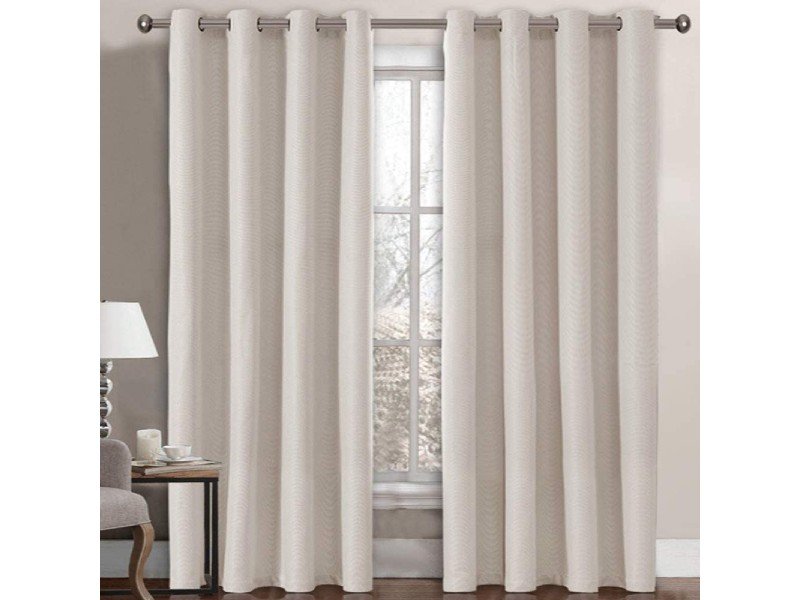
Our next contestant is a peculiar three-layer sandwich, unlike previous models. And it’s made from a different material: faux linen. So, what do we have here?
These sound and light-blocking curtains feature three levels of protection:
- The first linen layer takes the heat, so to say.
- Intermittent blackout layer hinders light and noise.
- And, finally, the plain layer adds a nice finishing touch to your decor.
This is a clever construction indeed that will nicely decrease the noise penetration from the outside: passing-by vehicles, street music, energy generators, seagulls shrieking, etc.
However, don’t expect any miraculous vacuum-like sound isolation: these curtains provide 65-70% at best. This must be enough to practice music in peace and quiet, at the same time minimizing the sound pollution from your side.
But if you live in a noisy area (near docks, airport, interstitial highway, carnival fair, etc.), these curtains won’t be much of help during a recording session. A bunch of unwanted noises will unavoidably intrude on your demo.
As for the light-canceling, they do a satisfying job, although a certain leakage will take place on a sunny afternoon. But I should admit, it depends on what curtains color you’ll pick: the darker it is, the harder it will be for the sunlight to travel through.
Even if they don’t provide supreme sound isolation, these are still the curtains that block sound — a decent choice. You can easily combine them with any decor: they smoothly blend in with both retro and modern interior.
No products found.
- Awesome versatility;
- Smooth pull;
- Decent light canceling;
- Nice color options.
- Won’t do for audio-recording.
5. NICETOWN 3 Pass Microfiber Noise Reducing — Semi-Pro Noise-Reduction Curtains
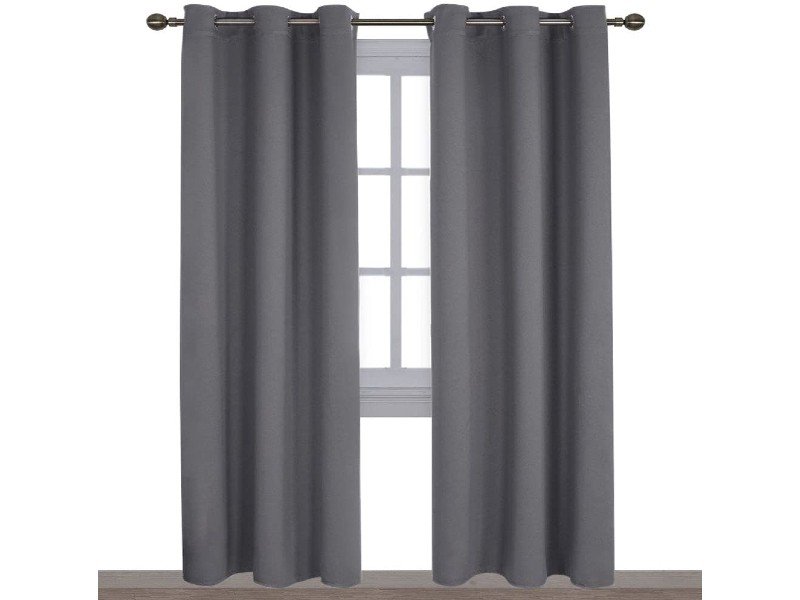
Another model from Nicetown offers 42-inch wide x 84-inch long panel curtains. And the main component here is polyester again. And the wealth of colors is still at your disposal: toffee brown, lilac, sea teal, teal blue, etc.
On the menu, we have the standard design with triple-weave blackout fabric. I guess Nicetown has a knack for making the sound-canceling drapes, as these curtains set a reliable and efficient noise threshold.
They look sort of lightweight, but it’s an illusion. We have 2.43 inches of thickness here. And it does a wonderful job at reflecting high/middle frequencies: a noisy bunch of kids, birds tweeting, and even a very distant construction site/highway.
However, don’t expect miracles at filtering out low-frequency noises from these curtains, especially those at 100 Hz or lower. So, if there’s a compressor unit somewhere nearby working every day, you will probably need metal curtains to stop that noise.
As for the blackouts, it’s not a 100% solution. They block sunlight with approximately 65% efficiency. This means adequately dark but with visible light leakage, especially at around 11:45-12:25 am. So, if you’re hypersensitive, I’d recommend looking elsewhere.
To sum up, I think they do a fairly good job at filtering out the city’s ambiance. (The average one, which is at about 10 Hz). So, if you’re on a budget but desperately want some peace, quiet, and privacy — why not try these?
No products found.
- Easy installation;
- Decent noise reduction;
- About 65% of light filtering;
- Color variety;
- Satisfying thickness.
- May not work for very sensitive people.
6. Deconovo Solid Grommet Blackout Curtains — 50% of Blackoutness
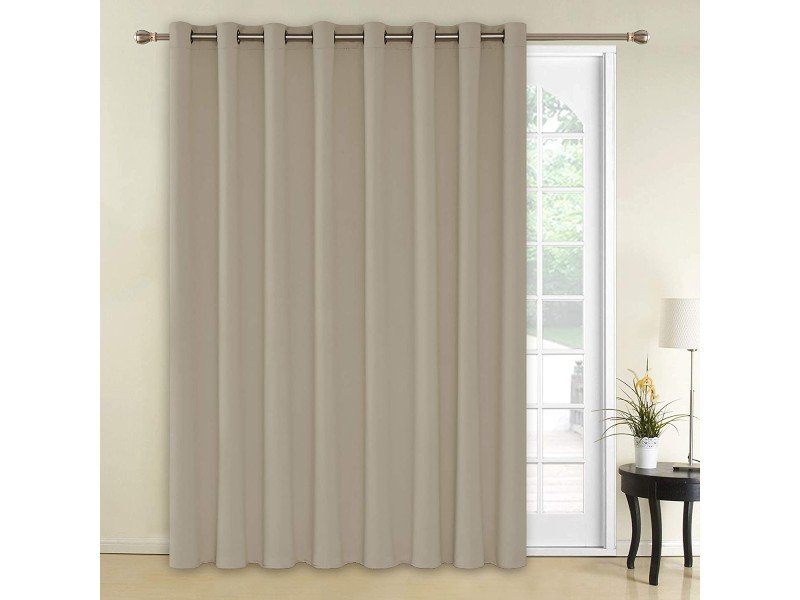
Our next item, Deconovo, is a set of panel drapes made entirely of polyester. How does it affect sound isolation?
Well, since polyester is a somewhat porous material, acoustic leakage is a common issue that comes with it hand in hand. However, it has a multi-layer construction, with the middle layer playing the central role in hindering rays and freqs.
I wouldn’t say these curtains actually block the noises from the outer world. Attenuation would be a more correct term. Or even ‘slight attenuation’.
For example, if you decide to practice the synth intro from Van Halen’s Jump at the max volume, it will be perfectly audible outside your house. With the exception of some high frequencies getting muffled.
And vice versa: only some high-spectrum noises coming from the street with a bit of mid-range freqs will be softened. I guess it can be explained by insufficient thickness.
The same refers to sunlight filtering. Deconovo can do it, of course, but on a very humble level. And you’ll be able to see early morning/sunset light gently beaming through it. This is a 50% blackout value at best, I assume.
At least, there are various size options here: from 52W x 63L-inch to 52W x 63L-inch. Not to mention the royal assortment of colors! Turquoise, Super Pink, Mellow Yellow, Purple Grape, and others.
So, if you’d like to sound-insulate your living room at least a bit — go with Deconovo. But I wouldn’t use them as a serious sound-canceling solution.
No products found.
- Polyester drapes;
- Variety of sizes;
- Satisfying light-filtering;
- Filters out high freqs;
- Easy maintenance.
- Won’t work as a pro remedy.
7. NICETOWN Extra-Wide Patio Door Curtains — Homely Sound-Deadening Curtains
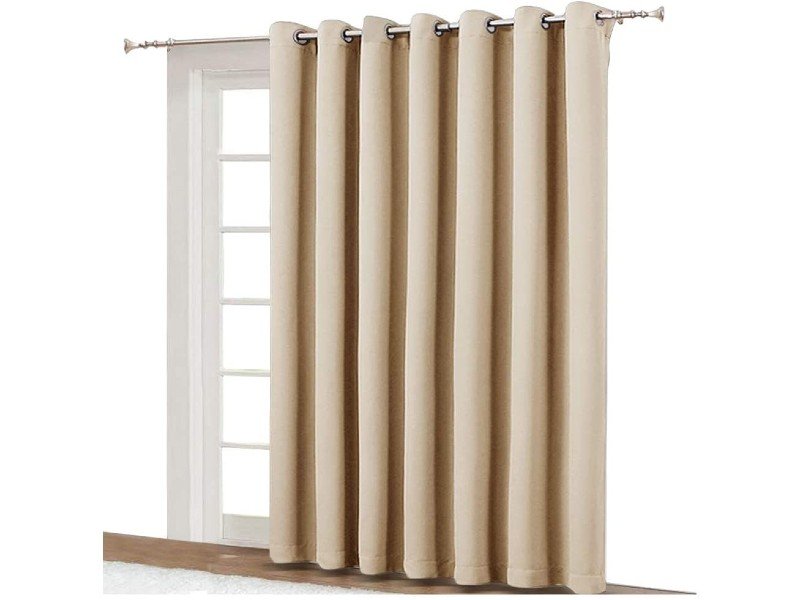
The final model is a set of sound-dampening curtains from Nicetown, which can both diminish unwanted noises and make your practice/recording space feel cozy. So, what’s on the menu?
We get some pretty universal curtains with the max size of W100″ x L108″. So, no matter where your music setup is — living room, basement, or bedroom — you can easily apply the drapes and get some sound-insulation.
The curtains are made of polyester. And while they can’t provide a total acoustic reticence, they do manage to kick some of the high-spectrum frequencies out of your studio. And though mids and lows will be pretty much audible, some nice attenuation will make them more bearable.
The curtains also do a decent job at ‘sun screening’. When you have your windows sealed with them, they don’t stifle all light. More about 65-70%, but it results in a mellow, delicate dimming. It seems like there’s a gentle eclipse in the middle of the day.
But what I especially like about these drapes, is their cozy design. If the snug atmosphere tickles your creative bone, you should definitely try them. As always, Nicetown offers a broad palette of colors from Burgundy Red to Royal Purple and iconic Black.
With all that, these extra wide curtains are a bit pricey. And Nicetown has way more affordable and effective models on this list. Unless you’re a big fan of coziness.
No products found.
- Balanced light & sound reduction;
- Cozy-looking design;
- Variety of colors;
- Impressive size;
- Quick installation.
- Pricey;
- Only 50% soundproof.
Buyer’s Guide on Soundproof Curtains
Do soundproof curtains work? Certainly! But before you place a set of curtains in your cart, check a few factors to consider when picking the right curtains.
How to choose the best soundproof curtains?
As I’ve said earlier, no curtains are 100% soundproof. It’s especially true about the low frequencies that go below 100 Hz: think of a drilling machine, and 808 bass blasting from a subwoofer, a plane flying at a 3,000 feet altitude, and so forth.
But as the experiments show, they can give you from 0.5 to 0.6 of the weighted sound absorption coefficient. Translate it to decibels, and you’ll get something in the region of 8-10 decibels, which is not bad at all. So, here are some factors that define good studio curtains.
Material & thickness
Virtually all the fabrics that curtains are made from are porous. It applies to cotton, satin, polyester, faux linen, and so forth. But there’s a trick to mitigate that factor: multi-layer construction.
This is why most of the quiet curtains from my list offer a three-layer construction, with the so-called blackout backing. They have a sandwich-like structure that compensates the pores and makes it harder for the sounds from the street to sneak inside your house.
Typically, the best material choices are velour, velvet, polyester, Japanese Noren, and so on. The reason is they offer a fair amount of density thanks to the fibrous texture.
And while not being completely soundproof, they do a satisfying job at absorbing certain frequencies. And as the golden rule from sound-engineering goes, the fewer freqs a sound has, the thinner its resonance is.
Noise Reduction Coefficient & echo
Noise Reduction Coefficient (or NRC) indicates how good fabric is at quieting the sound waves. It mainly applies to the noises you will be making inside your studio, though. Curtains with a higher NRC rate would be efficient at killing reverberation (echo).
And as you know, it’s actually a great thing for recording — the drier your drums or vocals are, the more you can do with them later using saturators, tape echo, distortion, flanging, and other beautifying techniques.
Unfortunately, they don’t test blackout curtains to measure NRC. But my bet is that you go for a thicker model, as it’s more efficient at trapping the sound waves. And when they get “caught”, they lose a major part of echo value.
Installation
However, sound-muffling comes at a price: all blackout curtains are much heavier than regular decorative drapery. Averagely. They start with 2.5 pounds and can make it to 4 or even 5 in some cases.
Naturally, heavy curtains for soundproofing require durable rods and heavyweight-supporting grommets.
Also, make sure that the grommets don’t feature any pompous embellishments as it can make pulling them problematic. And half-drawn curtains — even if there’s a 0.3-inch fissure — means more and more noise getting in.
So, I can recommend the wrap-around rods as the best option. They exclude crevices and gaps between the edges of the curtains thanks to their self-attaching construction. And this positively affects noise-canceling.
Double rods are also a good idea. First, they are great at handling even the heaviest drapes. (And, occasionally, a cat climbing up these drapes). Plus, you can use a little lifehack and put on an extra layer of curtains to double sound reduction.
Measurements
Before installing the curtains, you should do the following:
- Mounting. Decide if the curtains are going to be inside/outside the window frame.
- Trim mount. Inside, outside, or above the trim mount? This is important to avoid wasting time on remodeling later.
- Rod. It should be about 4-6 inches longer than your window, glass door, etc.
- Sill. Choose the length over it, below it, or stick to the floor length.
- Width. The drapery width would typically be from 1.5 to 3 times of your window width.
- Length. The curtain length goes from the rod pocket directly to the panel bottom.
This groundwork will help you select the right size, which impacts sound insulation directly: your windows must be entirely covered for better effect.
Hygiene & maintenance
Another important nuance: they must be machine-washable. Regularly, the water temperature for them should be 85 °F. And a mild detergent usage is possible.
But remember no bleaching. For starters, bleach can really mess up the colors of your curtains, making them ugly.
Second, such materials as polyester dramatically degrade and lose their density when you apply bleach. And it automatically means farewell to a quiet bedroom studio.
Light-blocking
Light doesn’t have much to do with sound in this case. However, keeping your workshop cooler in summer and warmer in winter is a dynamite idea. And it’s not just about spending less juice on air-conditioning.
If you happen to work with analog stuff: synthesizers, drum machines, effect pedals, audio-interfaces, you know, they have a knack for getting pretty hot during a creative session. Especially their power adapters.
So, the less sunlight sneaks in on a hot day — the better it is for your gear. Plus, many artists enjoy working in the dark. It makes your senses more acute. (Here’s an interesting essay on how it works).
Design
It may seem a trifle at first, but actually, decor aesthetics play a major role. As an artist, you should feel utterly comfy inside your creative space. For instance, if you can’t tolerate the mustard color or if turquoise gives you panic attacks — no amount of NRC will compensate for it.
FAQ About Soundproof Curtains
Let’s answer some popular questions about the curtains that reduce noise.
Do noise-blocking curtains really work?
The short answer is yes. They do but only to an extent. Noise-blocking curtains can provide sound muffling, smoothly softening middle and high frequencies. But they can’t provide studio-quality sound insulation alone.
Full acoustic treatment needs extra measures. You need to get rid of the tiny crevices that may be situated in your window frames, doors, and so on. As long as the air soaks in, so will the sounds from outside.
Then, STC-rated elements — like sound-blocking panels or doors — come into play. With them, you’ll be able to get closer to professional studio quality isolation.
Can I hang a blanket instead of a curtain?
Aesthetic issues aside, you can. But it can cope with the outside noise only to an extent. Mainly, it depends on which stuff your blanket is made from.
For example, wool does a decent job at dampening the sound. Actually, wool carpets have been a popular choice to muffle the noises in many mastering studios over the decades. Although opinions on their usefulness vary.
But a blanket should be a blanket: originally, it wasn’t designed to trap the sound and mitigate reverberation. But if there’s no other option for you so far, or you are waiting for your new soundproof curtains to be delivered, you should definitely try this, as music doesn’t wait!
What are the best soundproof curtains?
Thick, multi-layered, and heavy. Preferably with a dense fiber-texture, as it does a solid job at sound-insulating. Like Nicetown Blackout Curtain or H.Versailtex.
Do thick curtains reduce noise?
Yes, as it is common physics: the thicker the sound-blocking material is, the fewer acoustic frequencies will make it in. But thickness and mass should be correctly manipulated.
You need to identify first the so-called Flanking Path — the route through which the unwanted sound oozes in. For instance, if you have a window that faces a noisy street, your objective is to block it with a curtain (or even two curtains) first.
Are all blackout curtains noise-reducing?
Yes, they are. But efficiency may dramatically vary. The sound-blocking value mostly depends on materials and construction: thick soundproof curtains do the best job.
Play with Toys — Make Little Noise
I hope my today’s reviews will help you upgrade your setup. Follow my tips and make the first step to a more professional acoustic treatment right now — you deserve it. Having used Nicetown Blackout curtains for my practice, I felt the difference this item could provide.
Have you used soundproof curtains before? Do you think they work? Do you think curtains are a mistake in the acoustic treatment? Let us know in the comments!

